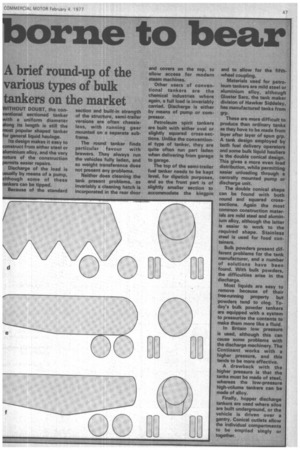A brief round-up of the various types of bulk tankers on the market
Page 49

If you've noticed an error in this article please click here to report it so we can fix it.
ITHOUT DOUBT, the cononal sectioned tanker a uniform diameter g its length is still the popular shaped tanker general liquid haulage. design makes it easy to ruct from either steel or miter alloy, and the very re of the construction its easier repairs.
ischarge of the load is ly by means of a pump, ough some of these ers can be tipped.
cause of the standard section and built-in strength of the structure, semi-trailer versions are often chassisless, with running gear mounted on a separate sub frame.
The round tanker finds particular favour with brewers. They always run the vehicles fully laden, and so weight transference does not present any problems.
Neither does cleaning the tank present problems, as invariably a cleaning hatch is incorporated in the rear door and covers on the top, to allow access for modern steam machines.
Other users of conventional tankers are the chemical industries where again, a full load is invariably carried. Discharge is either by means of pump or compressor.
Petroleum spirit tankers are built with either oval or slightly squared cross-sections. Unlike the conventional type of tanker, they are quite often run part laden when delivering from garage to garage.
The top of the semi-trailer fuel tanker needs to be kept level, for dipstick purposes, and so the front part is of slightly smaller section to accommodate the kingpin
and to allow for the fifthwheel coupling.
Materials used for petroleum tankers are mild steel or aluminium alloy, although Gloster Sam, the tank maker division of Hawker Siddeley, has manufactured tanks from grp.
These are more difficult to produce than ordinary tanks as they have to be made from layer after layer of spun grp. A tank design employed by both fuel delivery operators and some bulk liquid hauliers is the double conical design. This gives a more even load distribution, while permitting easier unloading through a centrally mounted pump or discharge unit.
The double conical shape can be found with both round and squared crosssections. Again the most common construction materials are mild steel and aluminium alloy, although the latter is easier to work to the required shape. Stainless steel is used for food containers.
Bulk powders present different problems for the tank manufacturer, and a number of solutions have been found. With bulk powders, the difficulties arise in the discharge.
Most liquids are easy to remove because of their free-running property but powders tend to clog. Today's bulk powder tankers are equipped with a system to pressurise the contents to make them more like a fluid.
In Britain low pressure is used, although this can cause some problems with the discharge machinery. The Continent works with a higher pressure, and this tends to be more effective.
A drawback with the higher pressure is that the tanks must be made of steel, whereas the low-pressure high-volume tankers can be made of alloy.
Finally, hopper discharge tankers are used where silos are built underground, or the vehicle is driven over a gantry. Conical outlets allow the individual compartments to be emptied singly or together.
































































































































